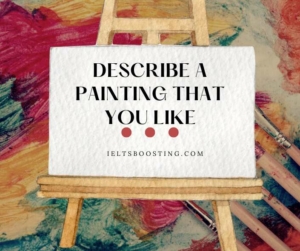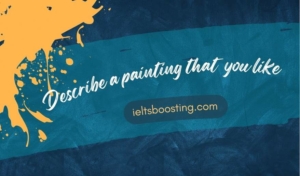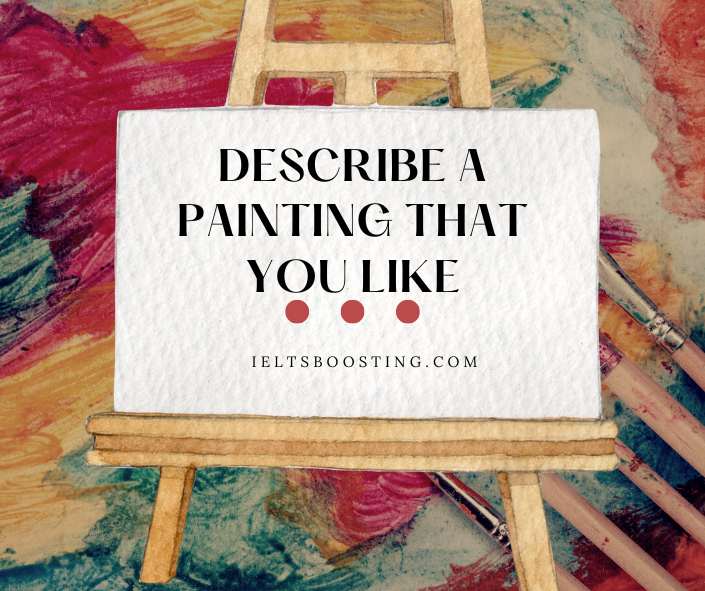Describe a painting that you like
You should say:
When you first saw this painting
What the painting is about
Who drew/painted it
And explain why you like this drawing/painting

Describe a painting that you like
Sample answer to describe a painting that you like
I’d like to talk about a remarkable painting that has left a lasting impression on me. I first encountered this painting during a visit to the Vietnam National Fine Arts Museum in Hanoi, which was a few years ago. The painting in question is titled “Rice Fields in the Morning Sunlight.” It’s a captivating piece that beautifully depicts the serene beauty of rural Vietnam. The scene features vast, lush green rice paddies under the gentle morning sunlight. The golden rays of the sun create a mesmerizing interplay of light and shadow, casting long, picturesque reflections of the farmers as they work in the fields. The painting skillfully captures the essence of rural life and the harmony between nature and the hardworking farmers.
This masterpiece was created by Nguyen Van Ty, a renowned Vietnamese artist known for his ability to portray the country’s rural landscapes with great finesse. His works are celebrated for their attention to detail and the way they evoke a sense of nostalgia for Vietnam’s countryside. I particularly admire this painting because it not only showcases the natural beauty of Vietnam but also reflects the resilience and dedication of the Vietnamese people. It reminds me of my roots and the strong connection that many Vietnamese have with their agricultural heritage.
Moreover, the artist’s skillful use of color and light adds depth and warmth to the painting, making it a truly captivating piece of art. In summary, “Rice Fields in the Morning Sunlight” is a masterpiece that captures the essence of rural Vietnam, and it resonates with me on a personal level due to its depiction of my country’s natural beauty and the hardworking spirit of its people.
High-level Vocabulary:
● Remarkable – Nổi bật
● Encounter – Gặp gỡ
● Captivating – Quyến rũ
● Serene – Thanh bình
● Interplay – Sự tương tác
● Mesmerizing – Cuốn hút
● Essence – Bản chất
● Resilience – Sự kiên cường
● Finesse – Sự tinh xảo
● Nostalgia – Nỗi nhớ về
Phrasal Verbs (Definitions in Vietnamese):
● Leave a lasting impression on – Để lại ấn tượng lâu dài
● Cast long reflections – Tạo ra những phản ánh dài
● Showcase the natural beauty – Trình diễn vẻ đẹp tự nhiên
● Resonate with – Gợi cảm giác, đồng cảm với
● Capture the essence – Bắt lấy bản chất

Describe a painting that you like
Explore more: ielts speaking part 2
Part 3-Describe a painting that you like
What are the differences between painting and drawing?
Painting and drawing are both forms of visual art, but they differ in techniques and materials used. Drawing usually involves tools like pencils, pens, or charcoal, and is often focused on line and form. Painting, on the other hand, uses brushes and paints, like watercolor, oil, or acrylic, and is more about the application of color and texture. While drawing is generally more about precision and detail, painting allows for a broader range of expression through strokes and color blending.”
Useful Vocabulary:
- Visual Art: Art forms that are primarily visual in nature, such as painting and drawing.
- Techniques: The ways of carrying out a particular task, especially artistic.
- Materials Used: The substances or components employed in creating an artwork.
- Line and Form: Fundamental elements in drawing, focusing on shapes and outlines.
- Brushes and Paints: Tools and mediums used in painting.
- Watercolor, Oil, Acrylic: Different types of paint mediums.
- Application of Color and Texture: The process of applying hues and surface quality in art.
- Precision and Detail: The accuracy and fine aspects in artistic work.
- Expression: The process of conveying thoughts or feelings through art.
- Color Blending: Mixing different colors to create new shades or effects.
Why do some people keep a painting for a long time?
Sample 1: People often retain paintings for extended periods due to their emotional significance and potential increase in value. A painting can evoke strong personal memories or sentiments, making it more than just a piece of art to the owner; additionally, over time, certain paintings can appreciate in value, especially if they are created by renowned artists or become rare. For example, a family might keep a landscape painting for generations because it depicts their ancestral hometown, and it may also become a valuable heirloom.
Sample 2: People often keep paintings for a long time for various sentimental and aesthetic reasons. A painting might hold personal significance, perhaps as a reminder of a special moment or as a cherished gift. Aesthetically, a painting can be a timeless piece of art that adds character and beauty to a space. Additionally, for some, paintings are seen as investments, potentially increasing in value over time.”
Useful Vocabulary:
- Sentimental Reasons: Emotional motives connected to feelings and memories.
- Aesthetic: Concerned with beauty or the appreciation of beauty.
- Personal Significance: Having special meaning or importance to an individual.
- Cherished Gift: A highly valued or treasured present.
- Timeless Piece: Something that remains stylish or valued regardless of age or era.
- Character: The distinctive nature or atmosphere of a place.
- Investments: Assets or items acquired with the goal of generating income or appreciation.
- Increasing in Value: Becoming more valuable or costly over time.
How does building style affect people’s lives?
Should children learn to draw and paint? Why?
Absolutely, I believe children should be encouraged to draw and paint. These activities foster creativity and imagination, which are essential skills for personal development. Drawing and painting also help in honing fine motor skills and hand-eye coordination in young children. Plus, they offer a form of emotional expression, allowing children to communicate feelings they might not yet be able to articulate in words.”
Useful Vocabulary:
- Encouraged: Given support or motivation to do something.
- Foster: To promote the development or growth of something.
- Creativity and Imagination: The ability to create and think of new ideas.
- Personal Development: The process of improving oneself.
- Honing Fine Motor Skills: Refining the small movements made by the hands and fingers.
- Hand-Eye Coordination: The ability to use the eyes to guide the movements of the hands.
- Emotional Expression: The act of conveying feelings.
- Communicate Feelings: To express emotions in a way others can understand.
- Articulate: To express clearly in words.
- Young Children: Kids at an early age or stage of development.
How do young people share arts with others?
Young people today have a myriad of ways to share their art with others, especially through digital platforms. Social media sites like Instagram or Pinterest are popular for showcasing artwork, reaching a wide and diverse audience. Online portfolios and personal websites also offer a more professional space to display their work. Additionally, local art exhibitions and school events provide physical venues for young people to share their artistic creations with the community.”
Useful Vocabulary:
- Myriad: A very large number of something.
- Digital Platforms: Online or electronic forums for communication and content sharing.
- Social Media Sites: Websites and applications that enable users to create and share content or to participate in social networking.
- Showcasing Artwork: Displaying or presenting art for others to see.
- Diverse Audience: A wide range of people with different backgrounds.
- Online Portfolios: Digital collections of a person’s work.
- Personal Websites: Websites created and maintained by an individual.
- Professional Space: A platform or area designed for career-related purposes.
- Local Art Exhibitions: Public displays of artwork in a local area.
- School Events: Organized activities or gatherings within an educational setting.
- Artistic Creations: Artworks or artistic outputs.
Do you think the objects we use in our daily lives should be beautifully designed?
I definitely believe that the objects we use daily should have an element of aesthetic appeal. Well-designed items can enhance our everyday experiences, making mundane tasks a bit more enjoyable. However, it’s crucial that beauty doesn’t compromise functionality – the items must still perform their intended purpose effectively. Striking a balance between form and function in design not only pleases the eye but also adds value to our daily routines.”
Useful Vocabulary:
- Aesthetic Appeal: The quality of being pleasing to the senses or to the mind.
- Well-Designed: Made with thoughtfulness towards functionality and appearance.
- Enhance: To improve the quality, value, or extent of something.
- Mundane Tasks: Ordinary, everyday jobs or chores.
- Compromise Functionality: To negatively affect how well something works.
- Intended Purpose: The main use or function for which something is made.
- Form and Function: The appearance and practical use of something.
- Pleases the Eye: Visually attractive or appealing.
- Adds Value: Increases worth or usefulness.
- Daily Routines: Regular, everyday activities or habits.
Xem thêm: sách luyện thi ielts


